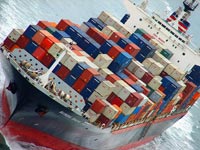 Containership operations has always been like riding a roller coaster, with many highs and lows and unexpected twists and turns. One sign of this is the fluctuating speeds of container ships over the years, going from slow to fast to slow to fast to and now to slow, once again.
Containership operations has always been like riding a roller coaster, with many highs and lows and unexpected twists and turns. One sign of this is the fluctuating speeds of container ships over the years, going from slow to fast to slow to fast to and now to slow, once again.
Slow Trip Across Sea Aids Profit and Environment
Many consider the Ideal X, a converted T2 tanker owned by Malcom McLean, which carried 58 containers in 1956, to be the first containership. The Ideal X had a top speed of around 15 knots. In 1972, McLean had built eight of the largest containerships in the world at the time, the magnificent SL-7s. They could carry 1,000 containers at 33 knots. They were indeed the clipper ships of the containership age and they steamed straight into the oil crisis of 1973, where oil prices tripled and continued to rise. The SL-7s were ultimately sold to the US Navy for conversion to Fast Sealift Ships.
Learning from the SL-7s, MacLean would later have twelve extremely efficient but slow “Jumbo Econships” built, which had a top speed of only 18 knots but could carry over 4,000 containers. By then oil prices had stabilized, the economy was in a recession and McLean was driven into bankruptcy.
Recently containerships with capacities of 15,000 containers, capable of 24 knots, have gone into service, only to sail into the teeth of a worldwide recession. Now containership operators have rediscovered the benefits of slow steaming, going from 24 knots to around 20, or in the case of Maersk Lines, going to “superslow steaming” speeds of around 12 knots. The world of containerships has gone from slow to fast to slow to fast to slow. One can only wait to see where the economics and the market move the throttle.
